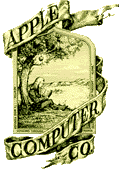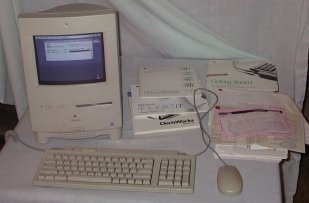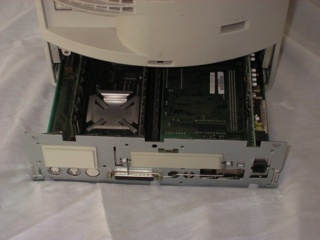

![]()
Promised since the beginning of time, or at least for a couple of years, here is the beginning of Rusted Mac. A collection of Mac items and information I found necessary in running my Macs. Someone may just find some of it useful.
|
Jump to Subheadings below:
|
 On our fourth anniversary JoAnna gave me four candles in a chocolate cupcake, who says women don't know what men want!  My Chinese Color Classic (OS 7.1T Chinese) complete with all original documentation and purchase receipts in Japanese Yen.  Power Color Classic - An entire 6300 motherboard chassis was fitted into this Color Classic by my brother (I only lent technical support). |
My first bit of information is a response from Darek of Emulators.com to my query about Power PC vs. Pentium that I call:
Darek, I have read and enjoyed your 'Dirty Little Secrets' for some time so I think I know your viewpoint on Mac OS and Power PC vs. Intel/AMD, but would really like to see some updates on the current core architecture of the Power PC vs. the latest (now working properly) Pentium 4. Is there anything to the debunking of the 'megahertz myth'? With the latest version of the PowerMac dual 1GHz machine running OS X 10.2 showing performance improvments of up to 20% over the previous dual 1 GHz system running X 10.1.4 [Here at DigitalVideoEditing.com] Are there OS, processor and memory system optimizations taking place here or is it just dumb luck? How can some kind of parity be measured between two DIFFERENT types of processors (power PC vs. Intel)? My 'real-world' measure is to encode a ten minute audio track into mp3 using various encoders on different machines, is this an accurate measurement of how good a processor is (even in a limited way)? I really appreciate your clear explanations, whether I agree or not (I STILL converted to Mac a year ago - and old 180MHz macs at that), as they make the debate understandable to this person who hasn't programmed in machine language since my Commodore 128! Thanks for taking the time to write your column or blog as the case may be. Russell - Unknown1 - Idaho USA
His Reply:
A comparison of the Intel/AMD and Motorola architectures is really beyond the scope of our web site. While I've certainly written tens of thousands of lines of code on the PowerPC, that's not relevant to the topics of discussion on our web site, namely, running of Macintosh software on the Intel/AMD based PC by means of Macintosh emulation, and comparisons of performace of such Intel/AMD systems. That's what our customers care about and what I give them advice on. Going off on a tangent and making comparisons of incompatible CPU architectures that PC owners don't even own is really a completely different topic and leads to the religios type of Mac vs. PC wars that I'm really not interested in. Besides, the latest news stories I'm seeing indicate that Apple and Motorola are having a falling out and that Apple may be switching to Intel/AMD for future versions of Mac OS, making the while issue moot anyway. Regarding the 20% improvement in speed of 10.2 over 10.1 - yippie. As I posted over 2 years ago now following the release of the Mac OS X public beta, Mac OS X is a hugely bloated slow pig that runs significantly slower than Mac OS 9 or other operating systems. Now while Apple did promise to clean up the code in the final Mac OS X, they didn't, it was a still a hugely bloated slow pig, and now over 18 months after the release of Mac OS X, Apple appears to finally give a shit about speed and performance. Hooray I guess, but all they're doing is delivering something that they were supposed to have delivered last year. Oh, and then charging another $129 upgrade fee in the process. Instead of being elated, you should be suing the pants off Apple for ripping you an extra $129. At Emulators here of course our philosophy is exactly the opposite of Apples - instead of writing code that barely and _then_ worrying about performance, we have always made speed the #1 priority and written efficient code in the first place. Our original 68000 emulator released 10 years ago ran on 386 and 486 chips. Our current SoftMac XP and Fusion PC and Gemulator products still run on 486 chips and run well, because there's been no speed slowdown in our code over the past 10 years. I still have two 486 machines right here next to my computer desk that I use every single day in order to keep making sure that our products run on 486 and run well. And when you run well on 486, you run very well on Pentium 3 and Pentium 4, making our 68K emulators the fastest there are. It's kind of speed oriented coding philosophy that most other companies don't have, especially Apple. Direct comparisons on incompatible processors are always hard because not only do things like clock speed and memory and efficiency of the core matter, but the quality of the code written. If you have a great C++ compiler on one platform and a stinker on another, that will affect the quality of the code, even if you compile the exact same C++ code. Another problem with the G4 is the clock speed limitation. While I have always like the G4 for being very efficient (something that I have mentioned in my Pentium 4 postings), it does suffer from the problem that Motorola is really not a one pony show like Intel is (unless Intel is suddenly in the cell phone business for example) and so upgrading the PowerPC has really not been a major concern for them given that Apple is one of their few customers for it. So while in the past 3 years we've been PCs go from 300 or 400 Mhz speeds up to 2 and 3 GHz, a 10 fold speed increase, the G4 platform has gone 400 to 1.25, a 3x improvement. This obviously has put the Mac far far back in terms of relative speed, regardless of the architecture differences, and is very likely a strong reason for the rift between Apple and Motorola. Add to that limitations such as the fact that the G4's memory bus isn't even fast enough to handle DDR memory. While Apple is putting DDR memory in their latest machines, the full bandwidth of that memory is not being utilized. So again, it's really not a matter of comparing PowerPC and Intel at this point. 3 years ago it was a good close race. But today the Intel/AMD platforms have increased in speed 3 times faster than the Mac platform, and thus Mac has falled far behind any way you cut it. The 1.5 Ghz PowerPC G5 chip, or whatever they're calling it, isn't due for another year or year and a half, and by then it will already be sadly out of date compared to the 3+ Ghz hyperthreading Pentium 4 and the 64-bit AMD Hammer running at 2+ GHz. The G4 may have run circles around the Pentium 4 - that was easy - but the G4 does not outpower the AMD Athlon and certainly won't come close to competing with the AMD Hammer if AMD lives up to the claims. Both the AMD Athlon and the Pentium III Tualatin achieve very good efficiency in terms of instructions per clock cycle, more so than either the Pentium 4 or even the older Pentium III chips from 2 years ago back when the G4 was still in the race. Mac users like to throw around those old Photoshop benchmarks from 2 years ago when 400 MHz systems were being compared, but those numbers are utterly useless and irrelevant today given the improvements on the PC side. So yes, hooray for Apple finally shaving 20% of bloat off Mac OS X, but it's well overdue, and you're still stuck with hardware that's running at the speed my PC hardware was at 2 years ago. Or in other word, PC hardware that I can put together today for a fraction of the cost of the Mac. I can build a dual Pentium III 1 GHz system with a gig of RAM and Windows XP for under $800. You want to show me dual 1 GHz Mac running Mac OS X for anywhere near that price? - Darek
What do you think? I don't agree with all of what he says, I know of some of the problems of the current PPC architecture, but I think there are some sour grapes here too. Discuss it on AppleFritter Forums, that's what I do...
The trains are now all where they
belong:
The
Idaho Narrow Gauge News
|
|

![]() Updated
28.11.2002
Updated
28.11.2002